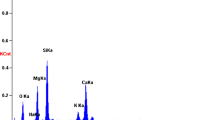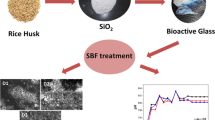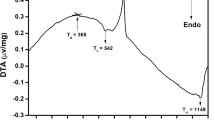Abstract
The purpose of the work is to prepare and assess soda lime silica-based (SiO2–CaO–Na2O) bioactive ceramics using biomass as renewable sources. Thus we produced SiO2–CaO–Na2O-based bioactive ceramics by sol–gel process using rice husk and eggshells as sources of silica and calcium oxide, respectively. The precursors such as calcinated eggshell powder, rice husk ash (RHA) and sodium hydroxide (NaOH) were processed by sol–gel method, resultant in SiO2–CaO–Na2O-based bioactive ceramics. The gel-derived sintered sample showed combeite high (Na6Ca3Si6O18) as a major crystalline phase. Subsequently, the sintered specimens were analyzed from the physical and structural point of view, and in terms of apatite mineralization rate in simulated environments and cytocompatibility in relative to human osteoblast-like cells. The studies showed that the produced crystalline SiO2–CaO–Na2O-based ceramics showed an average porosity of 45%. In vitro evaluation of the biological properties revealed that the prepared ceramics possesses the mineralization of carbonated hydroxyapatite (CHA) in simulated environment with good cytocompatibility and controlled degradation rate. Therefore, the results obtained suggest that the prepared SiO2–CaO–Na2O-based bioactive ceramics using biomass as renewable sources might be a low cost ceramics for applications in biomedical field.









Similar content being viewed by others
Availability of data and materials
Not applicable.
Code availability
Not applicable.
References
L.L. Hench, The story of Bioglass®. J. Mater. Sci. Mater. Med. (2016). https://doi.org/10.1007/s10856-006-0432-z
R.A. Surmenev, M.A. Surmeneva, A.A. Ivanova, Significance of calcium phosphate coatings for the enhancement of new bone osteogenesis—a review. Acta Biomater. (2014). https://doi.org/10.1016/j.actbio.2013.10.036
D. Madrid, Calcium phosphates as substitution of bone tissues. Prog. Solid State Chem. (2004). https://doi.org/10.1016/j.progsolidstchem.2004.07.001
G. Pezzotti, Bioceramics are not bioinert. Mater. Today. (2017). https://doi.org/10.1016/j.mattod.2017.06.008
S.M. Best, A.E. Porter, E.S. Thian, J. Huang, Bioceramics: past, present and for the future. J. Eur. Ceram. Soc. (2008). https://doi.org/10.1016/j.jeurceramsoc.2007.12.001
K. Lin, C. Wu, J. Chang, Advances in synthesis of calcium phosphate crystals with controlled size and shape. Acta Biomater. (2014). https://doi.org/10.1016/j.actbio.2014.06.017
T. Thamaraiselvi, S. Rajeswari, Biological evaluation of bioceramic materials-a review. Trends Biomater. Artif. Organs. 18, 1–21 (2004)
M. Vallet-Regí, E. Ruiz-Hernández, Bioceramics: from bone regeneration to cancer nanomedicine. Adv. Mater. (2011). https://doi.org/10.1002/adma.201101586
Y. Zhang, J.D. Santos, Crystallization and microstructure analysis of calcium phosphate-based glass ceramics for biomedical applications. J. Non. Cryst. Solids. (2000). https://doi.org/10.1016/S0022-3093(00)00115-0
S. Kumar, P. Vinatier, A. Levasseur, K.J. Rao, Investigations of structure and transport in lithium and silver borophosphate glasses. J. Solid State Chem. (2004). https://doi.org/10.1016/j.jssc.2003.12.034
D.B. Jaroch, D.C. Clupper, Modulation of zinc release from bioactive sol-gel derived SiO2-CaO-ZnO glasses and ceramics. J. Biomed. Mater. Res. Part A. (2007). https://doi.org/10.1002/jbm.a.31180
D. Arcos, M. Vallet-Regí, Sol-gel silica-based biomaterials and bone tissue regeneration. Acta Biomater. (2010). https://doi.org/10.1016/j.actbio.2010.02.012
J. Lao, J.M. Nedelec, P. Moretto, E. Jallot, Micro-PIXE characterization of interactions between a sol-gel derived bioactive glass and biological fluids. Nucl. Instrum. Methods Phys. Res. Sect. B Beam Interact. Mater. Atoms (2006). https://doi.org/10.1016/j.nimb.2005.12.049
C. Ergun, Z. Evis, T.J. Webster, F.C. Sahin, Synthesis and microstructural characterization of nano-size calcium phosphates with different stoichiometry. Ceram. Int. (2011). https://doi.org/10.1016/j.ceramint.2010.11.004
K. Zheng, A.R. Boccaccini, Sol-gel processing of bioactive glass nanoparticles: a review. Adv. Colloid Interface Sci. (2017). https://doi.org/10.1016/j.cis.2017.03.008
H.B. Dizaji, T. Zeng, I. Hartmann, D. Enke, T. Schliermann, V. Lenz, M. Bidabadi, Generation of high quality biogenic silica by combustion of rice husk and rice straw combined with pre- and post-treatment strategies—a review. Appl. Sci. (2019). https://doi.org/10.3390/app9061083
A. Zareihassangheshlaghi, H.B. Dizaji, T. Zeng, P. Huth, T. Ruf, R. Denecke, D. Enke, Behavior of metal impurities on surface and bulk of biogenic silica from rice husk combustion and the impact on ash-melting tendency. ACS Sustain. Chem. Eng. (2020). https://doi.org/10.1021/acssuschemeng.0c01484
S. Vichaphund, M. Kitiwan, D. Atong, P. Thavorniti, Microwave synthesis of wollastonite powder from eggshells. J. Eur. Ceram. Soc. (2011). https://doi.org/10.1016/j.jeurceramsoc.2011.02.026
R. Jayasree, J. Velkumar, T.S. Sampath Kumar, Egg shell derived apatite cement for the treatment of angular periodontal defects: a preliminary clinical and radiographic assessment. Dent. Oral Craniofac. Res. (2017). https://doi.org/10.15761/docr.1000238
R. Abu, R. Yahya, S. Neon, Production of high purity amorphous silica from rice husk. Proc. Chem. (2016). https://doi.org/10.1016/j.proche.2016.03.092
ASTM International, Standard test methods for density of compacted or sintered powder metallurgy (PM) products using Archimedes’ principle. ASTM B962-13 (2013). https://doi.org/10.1520/B0962-17.2
T. Kokubo, H. Takadama, How useful is SBF in predicting in vivo bone bioactivity? Biomaterials (2006). https://doi.org/10.1016/j.biomaterials.2006.01.017
T. Kokubo, H. Kushitani, S. Sakka, T. Kitsugi, T. Yamamuro, Solutions able to reproduce in vivo surface-structure changes in bioactive glass-ceramic A-W3. J. Biomed. Mater. Res. (1990). https://doi.org/10.1002/jbm.820240607
S. Palakurthy, In vitro evaluation of silver doped wollastonite synthesized from natural waste for biomedical applications. Ceram. Int. (2019). https://doi.org/10.1016/j.ceramint.2019.03.169
A. Oki, B. Parveen, S. Hossain, S. Adeniji, H. Donahue, Preparation and in vitro bioactivity of zinc containing sol-gel-derived bioglass materials. J. Biomed. Mater. Res. Part A. (2004). https://doi.org/10.1002/jbm.a.20070
M. Montazerian, B.E. Yekta, V.K. Marghussian, C.F. Bellani, R.L. Siqueira, E.D. Zanotto, Bioactivity and cell proliferation in radiopaque gel-derived CaO-P2O5-SiO2-ZrO2 glass and glass-ceramic powders. Mater. Sci. Eng. C. (2015). https://doi.org/10.1016/j.msec.2015.05.065
S.A. Hassanzadeh-Tabrizi, E. Taheri-Nassaj, Effects of milling and calcination temperature on the compressibility and sinterability of a nanocrystalline Al2O3-Y3Al5O12 composite powder. J. Am. Ceram. Soc. (2008). https://doi.org/10.1111/j.1551-2916.2008.02727.x
R. Choudhary, S.K. Venkatraman, A. Chatterjee, J. Vecstaudza, M.J. Yáñez-Gascón, H. Pérez-Sánchez, J. Locs, J. Abraham, S. Swamiappan, Biomineralization, antibacterial activity and mechanical properties of biowaste derived diopside nanopowders. Adv. Powder Technol. (2019). https://doi.org/10.1016/j.apt.2019.06.014
R. Lakshmi, V. Velmurugan, S. Sasikumar, Preparation and phase evolution of wollastonite by sol-gel combustion method using sucrose as the fuel. Combust. Sci. Technol. (2013). https://doi.org/10.1080/00102202.2013.835308
R. Du, J. Chang, Preparation and characterization of bioactive sol-gel-derived Na2Ca2 Si3O9. J. Mater. Sci. Mater. Med. (2004). https://doi.org/10.1007/s10856-004-5736-2
J.P. Nayak, S. Kumar, J. Bera, Sol-gel synthesis of bioglass-ceramics using rice husk ash as a source for silica and its characterization. J. Non. Cryst. Solids. (2010). https://doi.org/10.1016/j.jnoncrysol.2010.04.041
S. Palakurthy, R.K. Samudrala, In vitro bioactivity and degradation behaviour of β-wollastonite derived from natural waste. Mater. Sci. Eng. C. (2019). https://doi.org/10.1016/j.msec.2018.12.101
C.A. Fernández, C.A. Martínez, M.O. Prado, D. Olmedo, A. Ozols, Bone regeneration with Wharton’s Jelly-bioceramic-bioglass composite. Proc. Mater. Sci. (2015). https://doi.org/10.1016/j.mspro.2015.04.026
H.C. Li, D.G. Wang, C.Z. Chen, Effect of zinc oxide and zirconia on structure, degradability and in vitro bioactivity of wollastonite. Ceram. Int. (2015). https://doi.org/10.1016/j.ceramint.2015.04.117
J.H. Kim, S.H. Kim, H.K. Kim, T. Akaike, S.C. Kim, Synthesis and characterization of hydroxyapatite crystals: a review study on the analytical methods. J. Biomed. Mater. Res. (2002). https://doi.org/10.1002/jbm.10280
C. Ohtsuki, T. Kokubo, K. Takatsuka, T. Yamamuro, Compositional dependence of bioactivity of glasses in the system CaO-SiO2-P2O5: its in vitro evaluation. J. Ceram. Soc. Japan. Int. Ed. (1991). https://doi.org/10.2109/jcersj.99.1
R. Samudrala, P.A. Azeem, V. Penugurti, B. Manavathi, Cytocompatibility studies of titania-doped calcium borosilicate bioactive glasses in-vitro. Mater. Sci. Eng. C. (2017). https://doi.org/10.1016/j.msec.2017.03.245
K. Lin, M. Zhang, W. Zhai, H. Qu, J. Chang, Fabrication and characterization of hydroxyapatite/wollastonite composite bioceramics with controllable properties for hard tissue repair. J. Am. Ceram. Soc. (2011). https://doi.org/10.1111/j.1551-2916.2010.04046.x
M. Zahedi, S.A. Hassanzadeh-Tabrizi, A. Saffar-Teluri, Sol-gel synthesis and luminescence properties of Ba2SiO4:Sm3+ nanostructured phosphors. Ceram. Int. (2018). https://doi.org/10.1016/j.ceramint.2018.03.006
Q.Z. Chen, I.D. Thompson, A.R. Boccaccini, 45S5 Bioglass-derived glass—ceramic scaffolds for bone tissue engineering. Biomaterials (2006). https://doi.org/10.1016/j.biomaterials.2005.11.025
L.L. Hench, Bioceramics. J. Am. Ceram. Soc. 81, 1705–1728 (1998)
O. Peitl, E. Dutra Zanotto, L.L. Hench, Highly bioactive P2O5-Na2O-CaO-SiO2 glass-ceramics. J. Non. Cryst. Solids. (2001). https://doi.org/10.1016/S0022-3093(01)00822-5
H.A. Abo-Mosallam, S.N. Salama, S.M. Salman, Formulation and characterization of glass-ceramics based on Na2Ca2Si3O9-Ca5(PO4)3F-Mg2SiO4-system in relation to their biological activity. J. Mater. Sci. Mater. Med. (2009). https://doi.org/10.1007/s10856-009-3811-4
A.M. Galow, A. Rebl, D. Koczan, S.M. Bonk, W. Baumann, J. Gimsa, Increased osteoblast viability at alkaline pH in vitro provides a new perspective on bone regeneration. Biochem. Biophys. Reports. (2017). https://doi.org/10.1016/j.bbrep.2017.02.001
EN-ISO-10993-14, Biological evaluation of medical devices—part 14: identification and quantification of degradation products from ceramics. ISO 10993-142001 (2001). Accessed 15 Nov 2001
E. Fiume, J. Barberi, E. Vern, F. Baino, Bioactive glasses: from parent 45s5 composition to scaffold-assisted tissue-healing therapies. J Funct Biomater. (2018). https://doi.org/10.3390/jfb9010024
International Organization for Standardization, Biological evaluation of medical devices—part 5: tests for in vitro cytotoxicity. ISO 10993-5 (2009). Accessed 1 June 2009
P. Valerio, M.M. Pereira, A.M. Goes, M.F. Leite, The effect of ionic products from bioactive glass dissolution on osteoblast proliferation and collagen production. Biomaterials (2004). https://doi.org/10.1016/j.biomaterials.2003.09.086
S. Maeno, Y. Niki, H. Matsumoto, H. Morioka, T. Yatabe, A. Funayama, Y. Toyama, T. Taguchi, J. Tanaka, The effect of calcium ion concentration on osteoblast viability, proliferation and differentiation in monolayer and 3D culture. Biomaterials (2005). https://doi.org/10.1016/j.biomaterials.2005.01.006
M. Cerruti, N. Sahai, Silicate biomaterials for orthopaedic and dental implants. Rev. Miner. Geochem. (2006). https://doi.org/10.2138/rmg.2006.64.9
Y. Ramaswamy, C. Wu, H. Zhou, H. Zreiqat, Biological response of human bone cells to zinc-modified Ca-Si-based ceramics. Acta Biomater. (2008). https://doi.org/10.1016/j.actbio.2008.04.014
C. Wu, Y. Ramaswamy, D. Kwik, H. Zreiqat, The effect of strontium incorporation into CaSiO3 ceramics on their physical and biological properties. Biomaterials (2007). https://doi.org/10.1016/j.biomaterials.2007.04.002
Acknowledgements
The authors would like to thank MHRD & Science and Engineering Research Board, India for financial assistance (Ref: Letter No. EMR/2016/006870). We also thank the Director, National Institute of Technology, Warangal for providing us with facilities to carrying out the experiments.
Funding
This study was funded by Science and Engineering Research Board, India (Grant Number EMR/2016/006870).
Author information
Authors and Affiliations
Corresponding author
Ethics declarations
Conflict of interest
The authors have no conflicts of interest to declare that are relevant to the content of this article.
Ethical approval
Not applicable.
Consent to participate
I, P. Abdul Azeem voluntarily agree to participate in this research study.
Consent for publication
I, P. Abdul Azeem hereby declare that I participated in the study and in the development of the manuscript. I have read the final version and give my consent for the article to be published in Journal of the Korean Ceramics Society.
Additional information
Publisher's Note
Springer Nature remains neutral with regard to jurisdictional claims in published maps and institutional affiliations.
Rights and permissions
About this article
Cite this article
Palakurthy, S., Azeem, P.A. & Reddy, K.V. Sol–gel synthesis of soda lime silica-based bioceramics using biomass as renewable sources. J. Korean Ceram. Soc. 59, 76–85 (2022). https://doi.org/10.1007/s43207-021-00163-z
Received:
Revised:
Accepted:
Published:
Issue Date:
DOI: https://doi.org/10.1007/s43207-021-00163-z




